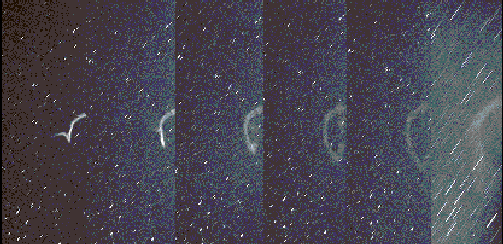Explanation: The Leonid Meteor Shower will likely reach its peak in the early hours this Monday morning. Though the Moon will be bright, Leo, the shower's radiant point, will be well above the eastern horizon from Western North America and the Pacific region during this period. This year's Leonids may prove particularly exciting as observers anticipate the legendary Leonid storm of activity will occur sometime during the next few apparitions of this annual meteor shower - although most expect the meteor storm to occur in 1998 or 1999. Meteor showers result from debris left by passing comets. The Leonids specifically are small pieces of Comet Tempel-Tuttle. In the above series of time-lapse, 1-minute exposures, a 1995 Leonid is seen to leave a train of hot air that glowed persistently for several minutes.
1999 2000 2001 2002 2003 2004 2005 2006 2007 2008 2009 2010 2011 2012 2013 2014 2015 2016 2017 2018 2019 2020 2021 2022 2023 2024 2025 |
Yanvar' Fevral' Mart Aprel' Mai Iyun' Iyul' Avgust Sentyabr' Oktyabr' Noyabr' Dekabr' |
NASA Web Site Statements, Warnings, and Disclaimers
NASA Official: Jay Norris. Specific rights apply.
A service of: LHEA at NASA / GSFC
& Michigan Tech. U.
|
Publikacii s klyuchevymi slovami:
Leonids - meteor shower - kometa Tempelya-Tuttlya - Meteor - Meteornyi potok - Leonidy
Publikacii so slovami: Leonids - meteor shower - kometa Tempelya-Tuttlya - Meteor - Meteornyi potok - Leonidy | |
Sm. takzhe:
Vse publikacii na tu zhe temu >> | |
